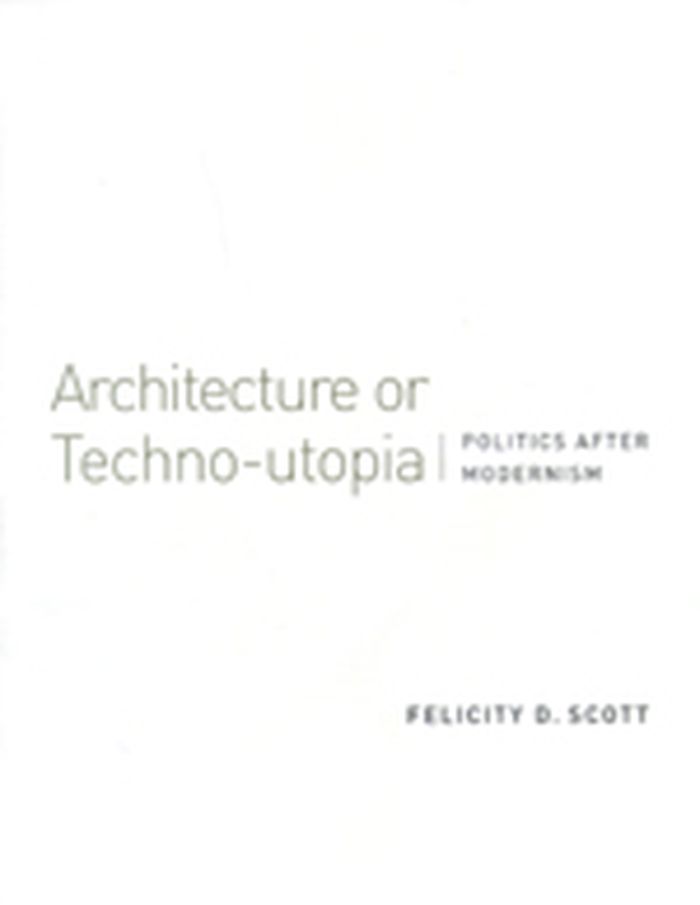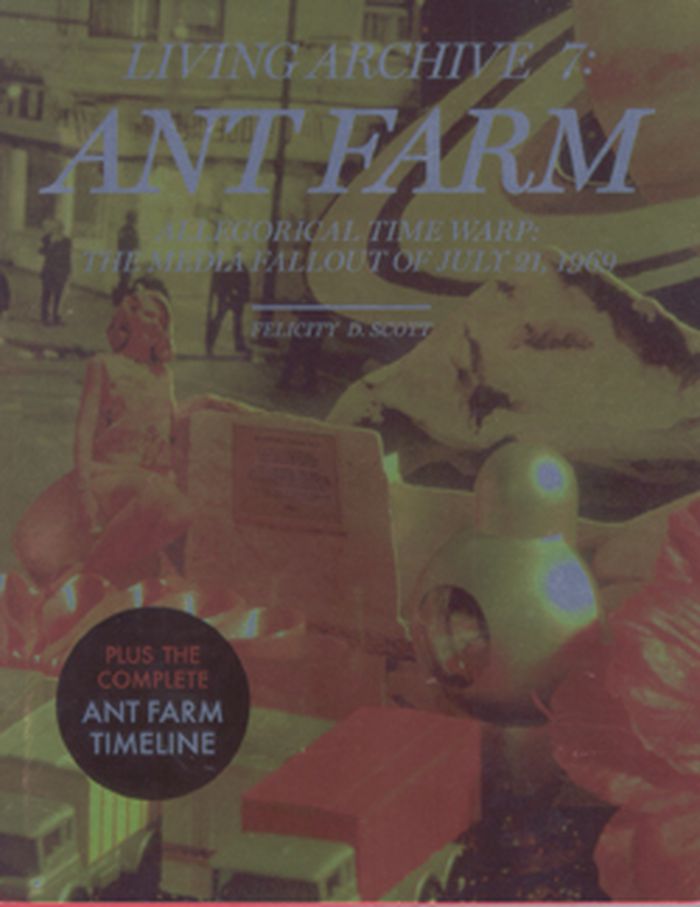$35.00
(disponible sur commande)
Résumé:
In Architecture or Techno-Utopia, Felicity Scott traces an alternative genealogy of the postmodern turn in American architecture, focusing on a set of experimental practices and polemics that emerged in the late 1960s and early 1970s. Scott examines projects, conceptual work, exhibitions, publications, pedagogical initiatives, and agitprop performances that had as their(...)
Théorie de l’architecture
novembre 2007, Cambridge, London
Architecture or Techno-utopia : politics after modernism
Actions:
Prix:
$35.00
(disponible sur commande)
Résumé:
In Architecture or Techno-Utopia, Felicity Scott traces an alternative genealogy of the postmodern turn in American architecture, focusing on a set of experimental practices and polemics that emerged in the late 1960s and early 1970s. Scott examines projects, conceptual work, exhibitions, publications, pedagogical initiatives, and agitprop performances that had as their premise the belief that architecture could be ethically and politically relevant. Although most of these strategies were far from the mainstream of American architectural practice, Scott suggests that their ambition-the demonstration of architecture's ongoing potential for social and political engagement-was nonetheless remarkable.
Théorie de l’architecture
$31.95
(disponible sur commande)
Résumé:
Architecture or Techno-Utopia offers a detailed account of the ways in which the work of architects and designers can speak to the contemporary condition. Felicity Scott traces an alternative genealogy of the postmodern turn in American architecture, focusing on a set of experimental practices and polemics that emerged in the late 1960s and early 1970s.
avril 2010
Architecture or Techno-utopia: Politics after Modernism
Actions:
Prix:
$31.95
(disponible sur commande)
Résumé:
Architecture or Techno-Utopia offers a detailed account of the ways in which the work of architects and designers can speak to the contemporary condition. Felicity Scott traces an alternative genealogy of the postmodern turn in American architecture, focusing on a set of experimental practices and polemics that emerged in the late 1960s and early 1970s.
Grey room 31
$20.00
(disponible sur commande)
Résumé:
Feature: Kaira M.Cabanas: Yves Klein's Performative Realism Rosalyn Deutsche, Aruna D'Souza, Miwon Kwon, Ulrike Müller, Mignon Nixon, and Senam Okudzeto: Feminist Time: A Conversation Ed Eigen: On the record: J.M.W. Turner's Studies for the Burning of the Houses of Parliament and Other Uncertain Bequests to History John Hardwood: The Wound Man: George Nelson and the(...)
Revues
mai 2008, Cambridge
Grey room 31
Actions:
Prix:
$20.00
(disponible sur commande)
Résumé:
Feature: Kaira M.Cabanas: Yves Klein's Performative Realism Rosalyn Deutsche, Aruna D'Souza, Miwon Kwon, Ulrike Müller, Mignon Nixon, and Senam Okudzeto: Feminist Time: A Conversation Ed Eigen: On the record: J.M.W. Turner's Studies for the Burning of the Houses of Parliament and Other Uncertain Bequests to History John Hardwood: The Wound Man: George Nelson and the 'End of Architecture'. Tom Williams: Lipstick Ascending: Claes Oldenburg in New Haven in 1969.
Revues
$54.95
(disponible sur commande)
Résumé:
Ant Farm manifesto No. 853 bears the title 'Allegorical Time Warp': '... AMERICA, IN AN ALLEGORICAL TIME WARP / USING PRE ELECTRONIC, PRINT AGE TECHNIQUES / WELCOMES RETURNING SPACE HEROES / TICKER TAPE PARADE DOWN FIFTH AVENUE. / ALL I WANT TO DO IS EXPAND MY MIND ...' This book brings together two books bound within a single cover: 'Ant Farm Timeline' and 'Allegorical(...)
Architecture, monographies
janvier 2008, New York/Barcelona
Living archive 7: Ant Farm: allegorical time warp: the media fallout of July 21, 1969
Actions:
Prix:
$54.95
(disponible sur commande)
Résumé:
Ant Farm manifesto No. 853 bears the title 'Allegorical Time Warp': '... AMERICA, IN AN ALLEGORICAL TIME WARP / USING PRE ELECTRONIC, PRINT AGE TECHNIQUES / WELCOMES RETURNING SPACE HEROES / TICKER TAPE PARADE DOWN FIFTH AVENUE. / ALL I WANT TO DO IS EXPAND MY MIND ...' This book brings together two books bound within a single cover: 'Ant Farm Timeline' and 'Allegorical Time Warp: The Media Fallout of July 21, 1969'. In addition, the publication includes a small dossier of archival material related to Ant Farm's Truckstop Network project (1970-72). Introduced by Chip Lord, the timeline tells the story of Ant Farm's multifaceted experimental work over 114 pages, in as many full page illustrations of original material. The 'Allegorical Time Warp' by Felicity D. Scott, focused on the period from 1969 to 1972, tracks the transformations of an architectural project articulated simultaneously in open-ended media systems and closed life-support systems. The work of Ant Farm has been an archetype for a younger generation of artist's collectives. This publication offers to be the long awaited source for the material that surviced the fire of the collective's studio in august 1978.
Architecture, monographies
$56.95
(disponible sur commande)
Résumé:
In Outlaw Territories, Felicity Scott traces the relation of architecture and urbanism to human unsettlement and territorial insecurity during the 1960s and 1970s. Investigating a set of responses to the growing urban unrest in the developed and developing worlds, Scott revisits an era when the discipline of architecture staked out a role in global environmental(...)
Outlaw Territories: Environments of Insecurity/ Architectures of Counterinsurgency
Actions:
Prix:
$56.95
(disponible sur commande)
Résumé:
In Outlaw Territories, Felicity Scott traces the relation of architecture and urbanism to human unsettlement and territorial insecurity during the 1960s and 1970s. Investigating a set of responses to the growing urban unrest in the developed and developing worlds, Scott revisits an era when the discipline of architecture staked out a role in global environmental governance and the biopolitical management of populations. She describes architecture’s response to the displacement of persons brought on by migration, urbanization, environmental catastrophe, and warfare, and she traces architecture’s relationship to the material, environmental, psychological, and geopolitical transformations brought on by postindustrial technologies and neoliberal capitalism after World War II. At the height of the U.S.-led war in Vietnam and Cambodia, with ongoing decolonization struggles in many parts of the world, architecture not only emerged as a target of political agitation because of its inherent normativity but also became heavily enmeshed with military, legal, and humanitarian apparatuses, participating in scientific and technological research dedicated to questions of international management and security. Once architecture became aligned with a global matrix of forces concerned with the environment, economic development, migration, genocide, and war, its role shifted at times toward providing strategic expertise for institutions born of neoliberal capitalism. Scott investigates this nexus and questions how and to what ends architecture and the environment came to be intimately connected to the expanded exercise of power within the shifting geopolitical frameworks at this time.
Théorie de l’architecture
$32.00
(disponible sur commande)
Résumé:
In this volume, illustrated by noted contemporary painter Martin Beck, architectural historian Felicity D. Scott revisits the architect s readings of the vernacular in the United States and Japan, which resonate with his attempts to imagine architecture and cities that refused to communicate in a normative sense. Best known for curating Architecture without Architects,(...)
Théorie de l’architecture
mars 2016
Critical spatial practice 7: disorientation: Bernard Rudofsky in the empire of signs
Actions:
Prix:
$32.00
(disponible sur commande)
Résumé:
In this volume, illustrated by noted contemporary painter Martin Beck, architectural historian Felicity D. Scott revisits the architect s readings of the vernacular in the United States and Japan, which resonate with his attempts to imagine architecture and cities that refused to communicate in a normative sense. Best known for curating Architecture without Architects, the famous 1964 photography exhibition of vernacular, preindustrial structures at the Museum of Modern Art in New York, Rudofsky drew on decades of speculation about modern architecture and urbanism, particularly their semantic, technological, institutional, commercial and geopolitical influences. In a contemporary world saturated with visual information, Rudofsky s unconventional musings take on a heightened resonance.
Théorie de l’architecture





